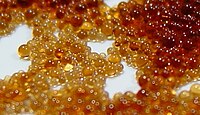
Photo from wikipedia
Asparagus (Asparagus officinalis L.) accumulates inulin- and inulin neoseries-type fructans. Fructose released by the hydrolysis of fructans is an energy source for emerging asparagus spears. Plant fructans are hydrolyzed by… Click to show full abstract
Asparagus (Asparagus officinalis L.) accumulates inulin- and inulin neoseries-type fructans. Fructose released by the hydrolysis of fructans is an energy source for emerging asparagus spears. Plant fructans are hydrolyzed by fructan exohydrolases (FEHs), whose presence in asparagus has not yet been fully characterized. Here, we describe for the first time the purification and characterization of an FEH from asparagus, and the functional analysis of its gene. The purified enzyme was predicted to exist as a dimer (approximately 130 kDa) consisting of two polypeptides with a molecular mass of approximately 68 kDa. N-terminal sequences of the purified enzyme were matched with the amino acid sequences of aoeh4a and aoeh4b cDNAs isolated from asparagus (cv. Gijnlim and Taihouwase). Native enzymes obtained from asparagus roots and recombinant enzymes produced by Pichia pastoris showed fructan 1-exohydrolase (1-FEH) activity via the hydrolysis of inulin-type fructan. Unlike other 1-FEHs, these enzymes showed minimal hydrolysis of 1-kestose but efficiently hydrolyzed neokestose. Therefore, the enzyme was termed 6G&1-FEH. Gene expression studies in asparagus roots showed that aoeh4 increased during root storage at 2 °C and spear harvesting. These findings suggest that 6G&1-FEH may be involved in fructan hydrolysis in asparagus roots to provide an energy source for emerging asparagus spears.
Journal Title: Journal of Experimental Botany
Year Published: 2018
Link to full text (if available)
Share on Social Media: Sign Up to like & get
recommendations!